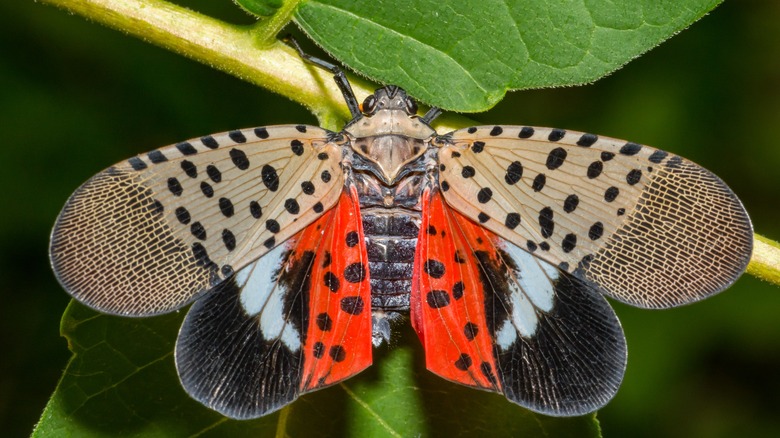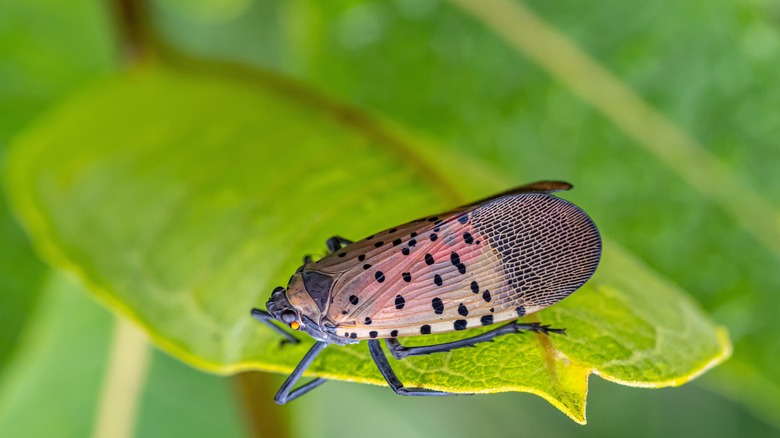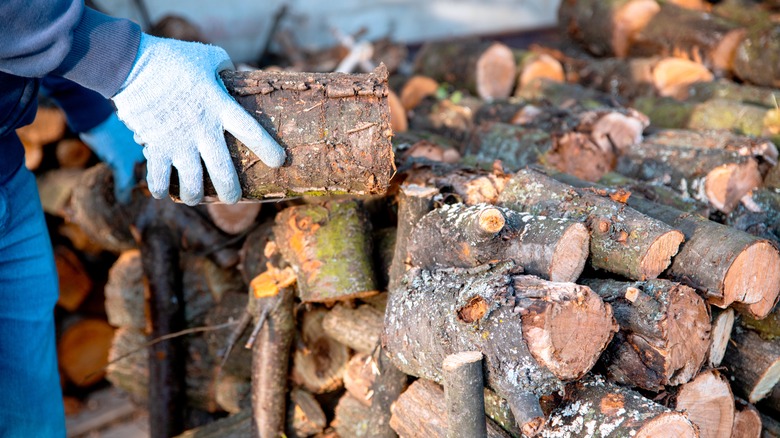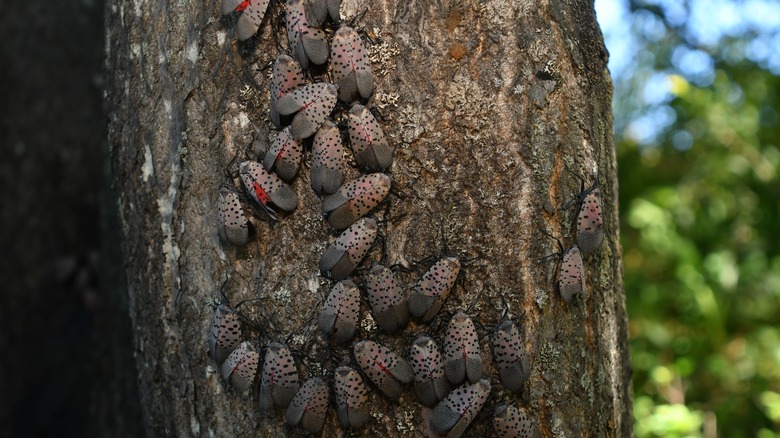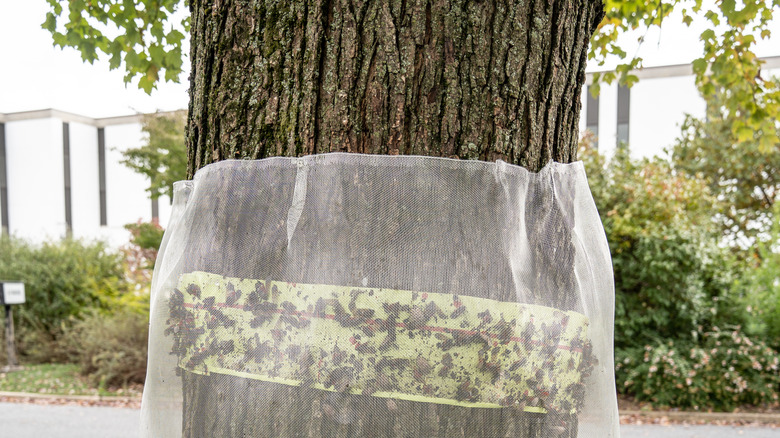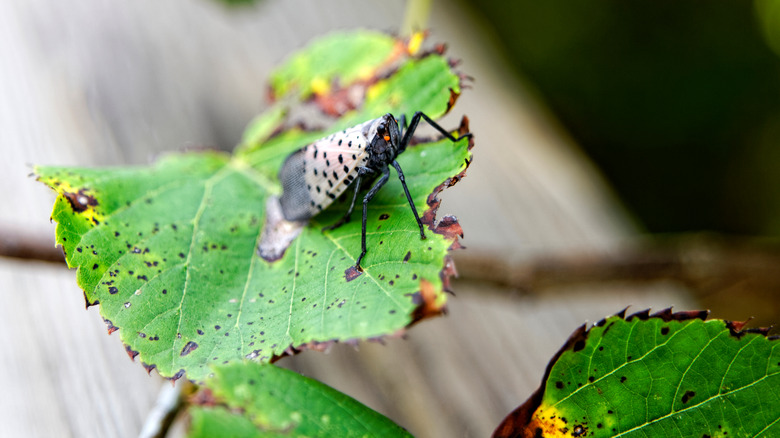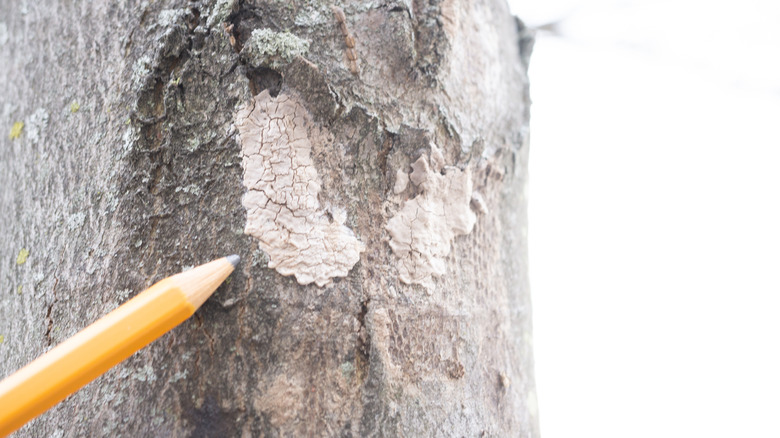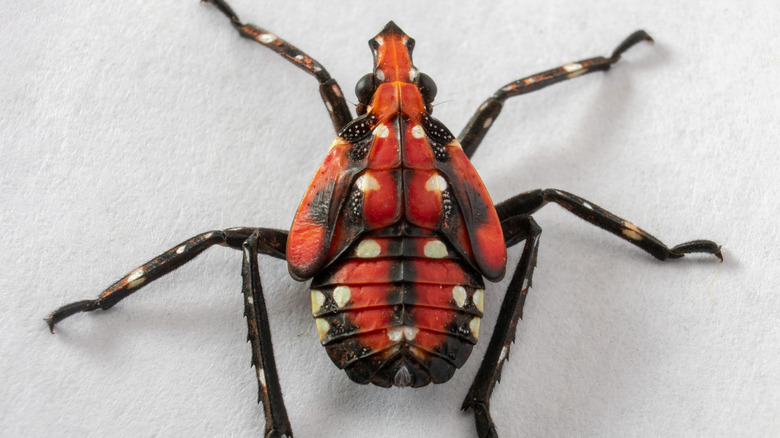What You Need To Know About Spotted Lanternflies
"Join the battle. Beat the bug!" That has been the rallying call in the national campaign to engage residents in war on the spotted lanternfly (Lycorma delicatula). How can a mere mortal foil such an invasion? The simple answer is stomp it out—yes smoosh the bugs with the heel of a shoe, which tends to be good advice for residents in the almost a dozen states the lanternfly is already calling home. But why all the stink about one hungry bug? True, we've all dealt with pests before—mosquitoes, ticks, fleas, you name it— but the spotted lanternfly has quickly risen to the most-wanted list in the states it has infiltrated. And, yes, it is an invasion.
According to the New Jersey Department of Agriculture, these extremely damaging pests are not native to the U.S. and hadn't been seen in this part of the world until 2014 when Berks County, Pennsylvania, confirmed the first appearance. Since then, this native of China, Vietnam, and India with a voracious appetite for over 70 different plant species, including big money-makers like grapes, has threatened many more states in the Northeast and Midwest. The lanternfly has been sighted in New Jersey, Delaware, Maryland, Virginia, West Virginia, New York, Connecticut, and Ohio—and has the right stuff to claim even more territory. In many cases, this planthopper just hitches a ride, and derailing its travels has meant quarantine protocols in some areas. What kind of threat does the spotted lanternfly pose in your neck of the woods and what can you do about it? Here's what the experts say.
Why the spotted lanternfly is a threat
The spotted lanternfly does not bite or sting humans, says the Natural History Museum in London. Its specialized mouth parts are strictly meant for sucking sap out of trees and plants like a little straw. And they certainly don't strike terror in our hearts the way "killer bees" might. But don't let the name fool you. The spotted lanternfly is a significant threat. With few natural predators in the United States, these hungry bugs are sucking the sap out of economically vital plants, like the black walnut and oaks. They can devour orchards and plummet the logging industry to bankruptcy if left unchecked.
For instance, if given full reign in Pennsylvania, the first state to sight this notorious bug, it is estimated that the financial blow could reach up to $324 million a year, eliminating 2,800 jobs, the National History Museum reports. If grape vineyards fall to the fly, now it's messing with an industry worth billions of dollars. Maybe you don't care much for a glass of wine with dinner, so the impact on orchards doesn't hit home. But the spotted lanternfly also threatens everything from almonds to walnuts as well as ornamental trees like maples and willows, says the U.S. Department of Agriculture. Even Christmas trees could be affected as pine trees are included on the list of myriad plants targeted by the spotted lanternfly.
Other lanternfly favorite dishes include apples, apricots, cherries, grapes, hops, nectarines, peaches, and plums. It's considered a planthopper and it's able to jump from meal to meal. Besides draining a plant's sap, the bug releases a honeydew substance that can cause mold and fungi to grow, which can take a toll on a tree. Time to get stomping!
How to identify the lanternfly and its nest
It's not a fly as the name suggests, and it's not a moth though, with its outstretched wings, it resembles one. The spotted lanternfly is a planthopper in the order of Hemiptera, or true bug, related to the cicada, stinkbug, aphids, and leafhoppers, says Cornell University. Don't count on a telltale red spot to give away the bug's identity. The lanternfly only shows such brilliance when in flight or startled, at which point it extends the red underwings. it's far more likely that you'll spot the lanternfly resting on the next tree it wants to snack on. In that case, it'll have its black-spotted, pinkish-tan wings folded back, hiding a yellow abdomen with black stripes.
In their early stage, offspring called nymphs are black with white spots and may be mistaken for ticks. As they mature, nymphs take on a red coloration still with white spots. You are most likely to see a nymph in May or June. Through each stage of development, the spotted lanternfly will molt, but its coloration is so distinctive you should still be able to make a positive identification.
Even if you don't see a lanternfly in action, the U.S. Department of Agriculture says you may detect signs of their presence around your yard. There is the telltale honeydew-like sticky fluid that can build up on plants and on the ground where lanternflies have been dining, creating a real mess. Out in the yard, if you feel drops of "rain" when there's not a cloud around, it may actually be the honeydew leaking down from a tree above. Targeted plants might also exhibit sooty mold, take on a fermented odor, and seem to ooze or weep. Egg masses on tree trunks, branches, rocks, lawn furniture — you name it— are another warning that the lanternfly is in town. These masses resemble gray or tan mud splotches extending about an inch long. Each contains 30 to 50 eggs—and the invasion begins!
What to do if you find a lanternfly or its nest
The best lanternfly is a dead lanternfly. In most cases, stomping the bug is the best course of action; however, if you find the spotted lanternfly in a new state where it has not yet been reported, a live capture is recommended, says the U.S. Department of Agriculture (USDA). Since the bugs are tough on trees but not on humans, the USDA says there's no reason to fear catching the lanternfly. Just plop it in a jar and freeze the pest for state identification purposes.
If you're in New Jersey, Pennsylvania, or another state known to be a lanternfly hangout, you'll want to report the sighting to the state Department of Agriculture. But there's no need to trap and freeze it. Instead, join the fight by taking photos and noting the location where you found the bug. Then go ahead and stomp it. To become an expert at identifying the spotted lanternfly, go to the USDA website which provides pictures of its various stages as well as lookalikes that might fool you. Yes, the lanternfly is not the only red bug in town, but one of the few triggering such alarm.
Living in a quarantine zone
COVID-19 is not the only reason for quarantines these days. The lanternfly has created the need for quarantine zones in areas where they are prevalent, like numerous New Jersey counties. Moving any object from these zones without inspecting it first is prohibited, says the New Jersey Department of Agriculture. Why quarantine zones? While its name suggests a propensity for flight, the lanternfly can also hop an impressive distance to its destination, which makes it a skilled hitchhiker. Even in its nymph stage, the insect is adept at getting around. And don't put it past them to drop into a vehicle or equipment and travel across state lines. This takes hitchhiking to a whole new level.
To comply with quarantine, one must inspect firewood, plants, packing materials like boxes, and landscaping or construction waste. Additional likely bug targets include outdoor household items like RVs, lawn mowers, grills, furniture, tile, stone, tarps, and deck boards. Vehicles kept outdoors can also taxi a bug to his next meal in another state. To stop the spread, the public is urged to examine these items and keep a compliance checklist before hitting the road...and unknowingly transporting a stowaway.
In some cases, businesses and organizations will need to get a permit to move material out of an affected county. These permits are only issued after training on preventing the spotted lanternfly's spread. For safe travel outside a quarantine zone, precautions might include storing vulnerable material indoors or shrink wrapping it, whatever it takes to keep it from feeding the bug and advancing its trek across the states. If a spotted lanternfly is discovered during the examination of materials awaiting transport, it is to be processed, treated, burned, or buried as the law requires. It should never be taken outside the quarantine zone.
How to know if lanternflies have invaded your yard
Besides the undeniable sight of lanternflies all converging to dine on a particular tree as is their custom, Mendham Garden Center in New Jersey suggests a few other telltale signs of this destructive pest. As spotted lanternflies draw the sap and nutrients out of a tree, they excrete a sugary, honeydew-like substance. Not only is this "honeydew" reflective of the lanternfly but it attracts ants and wasps to the tree — yet another giveaway. Also related to this sweet excretion can be the growth of a sooty, mold fungus. So, if your tree shows any of these unusual symptoms it's time to come to its rescue.
An affected tree may ooze sap out of its wounds and exhibit damage, such as wilting or curling leaves and individual dead branches. (It is being stripped of its nutrients after all by a bug well-equipped to do so with piercing-and-sucking apparatus.) These are common signs that any homeowner can detect and spring into action. Yet another indicator is the eggs, which are coated with a protective covering resembling light-brown mud. Look for these splotches not only on trees and plants, but on lawn furniture, patio tiles, and even the sides of buildings.
Stomping is not the only way to wipe out SLF
If your property is infested with spotted lanternflies, you're going to want to waste no time in kicking them out before eggs hatch and then the problem intensifies. Fortunately, French & Pickering Creeks Conservation Trust, based in Pennsylvania, has come up with ways to eradicate the bug without pesticides that could be harmful to bees. Topping the list is smushing the culprit with fly swatters, bug-zapping electric rackets, or anything else practical at your disposal. If you're not a fan of smooshing and squishing, consider sucking up a bunch of them with a shop vac.
Yet another option for a tree overcome with an army of the pests is wrapping the base of the trunk at least 4 feet off the ground with sticky paper or inside-out duct tape. (Narrow strips are less harmful to other critters.) To spring the trap, knock them out of the tree with a broom, leaf blower, or pressure washer. As they scurry back up the tree, they'll get stuck in the sticky paper. Caution: The sticky paper can harm other wildlife and should not be left unattended. Consider building a wire cage around the paper to protect wildlife. You might also try natural poisons like the milkweed plant, natural killers like spiders, and some essential oil-based pesticides that do minimal harm to beneficial insects. As mentioned the milkweed is a natural poison, which the Asian-native spotted lanternfly knows nothing about, and planting it in your yard will not only kill the bug, but it will also support monarch butterflies. How's that for a win-win?
Chop down the tree-of-heaven
One of the best tactics in the ongoing war against spotted lanternflies is chopping down the tree of heaven if you happen to have one growing in the yard. As strange as this sounds, lanternflies love to munch on the tree of heaven, and it's such a lure that homeowners are advised to cut the tree down if possible. Like the spotted lanternfly, the tree of heaven is an invasive species, also an intruder which can play havoc with the local ecosystem.
This tree has traveled from its native China and Taiwan and became a regular feature in Europe and North America, according to the Mendham Garden Center, calling it a highly undesirable weed tree. So, rev up that chainsaw and protect the rest of your plants from the spotted lanternfly. As long as the tree of heaven remains, it will be a magnet for that ravenous bug, which also craves trees of the deciduous variety, like apples, oaks, willows, nut trees, and maples. No doubt these other trees are prized additions to your landscaping and worth protecting from invasive species.
Combatting the myths about SLF
There are plenty of myths circulating about the spotted lanternfly that Penn State is trying to clear up. For instance, the nasty bugs target some 100 tree varieties but they are only a direct threat to grapes and the tree of heaven, which grows like a noxious weed tree. So, the fact is that the spotted lanternfly may not kill your trees. However, they may harm trees by leaving them in a weakened state and more susceptible to disease, other insects, and drought. Saplings may be especially vulnerable. Due to the legions of lanternflies that flock to a tree, Penn State says they will cause some impact. The exact nature of that impact is now under study.
A second myth is that the spotted lanternfly may have left a certain region. Even if sightings have dropped, perhaps because they've devoured all the food, there's no reason to believe they're gone for good. When the food comes back next season or next year, they may pop up again, perpetuating the cycle of destruction. Yet another myth has spotted lanternflies proving potentially toxic to pets who ingest them. Spotted lanternflies do not seem to contain cantharidin, poisonous in large doses, and present in bugs like beetles. There is no evidence they are toxic, says Penn State, citing the need for further research. At the very least they're hard to digest, so keep an eye on Fido.
Lastly, Penn State recommends avoiding home beat-the-bug remedies like dish soap, garlic, salt, vinegar, glass cleaner, and chili peppers, sticking to nonchemical options. Chemical control is an option but best left to a pro after careful research into the benefits and consequences of the insecticide chosen.
How to get rid of egg masses
Knowing about the life cycle of the lanternfly can help wipe it out, especially when it comes to its progeny contained in egg masses plastered about your yard. Adults will get busy laying eggs from September through December, and though Mom doesn't last the winter, her offspring will continue on to wreak havoc, says the New Jersey Department of Agriculture. Those masses are packed with up to 50 eggs and each female can lay up to two masses — scary, yes, but also a great opportunity to rid your property of this menace. From September through June, curious blobs of mud start appearing on trees and flat surfaces, ranging from light gray when new to tan and cracked later on. These are the nests.
Now that you can identify an egg mass, it's time to conduct a thorough search of your property, not overlooking ungaraged cars, rocks, decks and patios, metal and fence posts (really any hard surface), recommends Cornell College of Agriculture and Life Sciences. And scan your trees as well, looking 10 feet or more from the base, where most nests are found. Next, scrape the egg mass off the surface using anything hard, tapered, and/or flat. Scraper cards are made for this purpose but don't fear improvisation. Finally, kill the whole gang by putting the nest in double bags with alcohol or hand sanitizer. It also works to smash or burn them. All this takes knowledge and effort but lanternflies can be controlled at each stage of development.
The outlook for lanternflies
Since that fateful day in 2014 that the first spotted lanternfly was discovered in Berks County, Pennsylvania, the hungry bug has been gaining territory despite warnings and quarantine zones. To illustrate how good the bug is at getting around, the initial lanternfly is believed to have reached PA through a shipping container from its native Asia, according to The Washington Post. Besides making a big mess as it drops on everything under the dining lanternfly, the honeydew-like substance the bad bugs excrete can render fruit crops unusable, kill grape vines, and foul the taste of honey. While it doesn't kill trees per say, it is a huge concern for the future viability of orchards.
During the summer of 2022, The Washington Post reports, the spotted lanternfly entered Loudoun County in Virginia, marking a significant victory for the bug. A map of the United States featured in the article shows the planthoppers are making progress in the Mid-Atlantic States with heavy populations in New Jersey, Delaware, and Maryland, and pockets of activity in Ohio, Virginia, New York, Connecticut, and Massachusetts. There are even small infestations in Indiana and North Carolina. The future, says the article, may mean creating biologically-based insecticides perhaps through an insect-killing fungus now being investigated. No, the stomping isn't over. Nor is the need for residents to take up arms to combat what could be an economically devastating bug invasion before it's too late.
